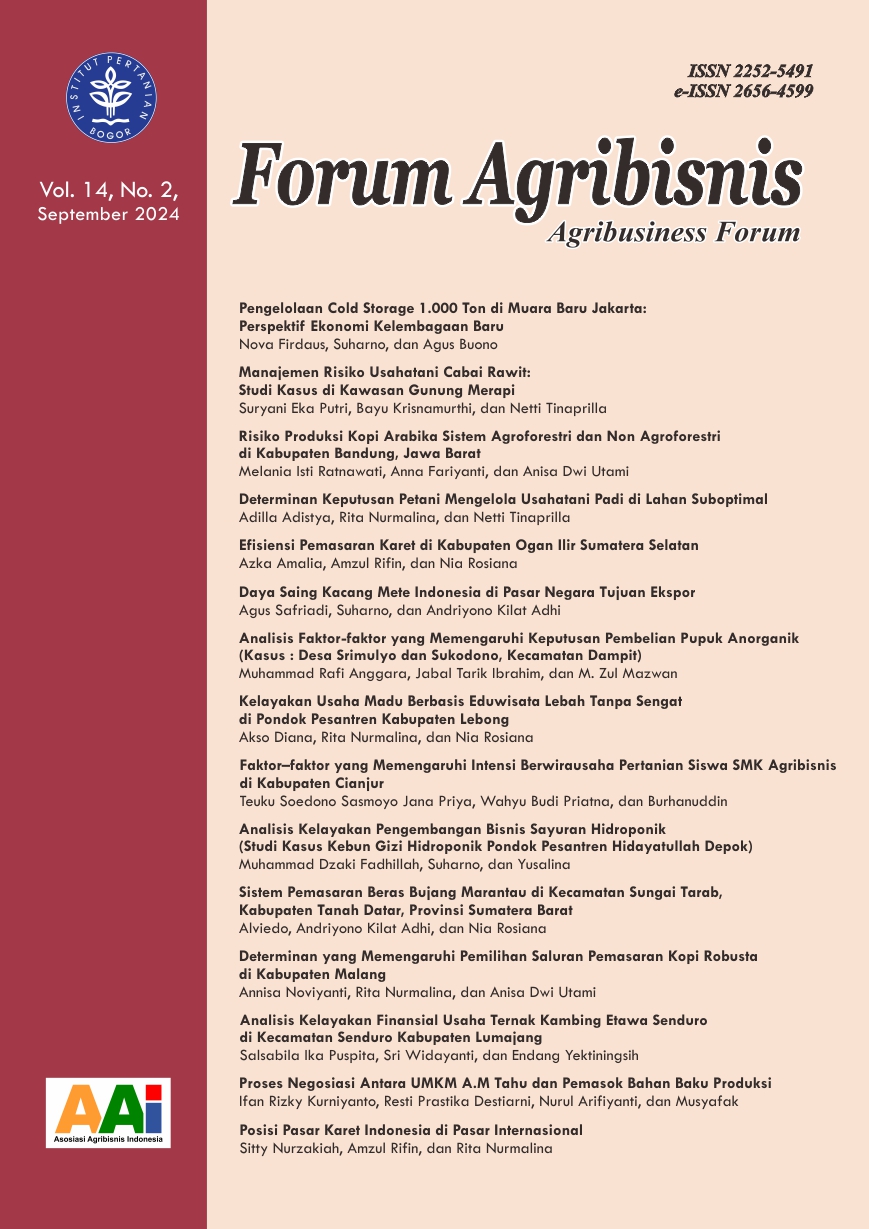Posisi Pasar Karet Indonesia Di Pasar Internasional
Main Article Content
Abstract
Indonesia's position as the largest rubber producing country in the world allows them to become the main exporter of natural rubber. Indonesia exports the majority of its natural rubber production to countries like Japan, India, Brazil, the United States, South Korea, China, Turkey, and others. The competition between Indonesia and other producing countries in exporting rubbers to international markets is relatively tight. The aim of this research is to analyze the position of Indonesia’s technically specified natural rubbers (TSNR) in the international market compared to other exporting countries. The analytical method used is the Almost Ideal Demand System (AIDS) Model. The data used in this research is secondary data from Indonesia, Thailand, Malaysia, Ivory Coast, Vietnam, Belgium, and Nigeria over the last 10 years (2012 – 2022). The results show that there is a tight competition between Indonesia and Thailand, Ivory Coast, Belgium, Nigeria and the Rest of the World in competing for market share of natural rubber in the international market because the relationship between Indonesia's natural rubber and these countries are substitutional. Meanwhile, Indonesia's natural rubber relationship with Malaysia is complementary. Indonesian natural rubber is a normal good, so if there is an increase in prices it will cause a decrease in demand. If there is an increase in demand for rubber exports in the international market, then the country that will benefit the most is Vietnam. Meanwhile, Indonesia is the fourth ranked country that will benefit the most if it happens.
Downloads
Article Details

This work is licensed under a Creative Commons Attribution-ShareAlike 4.0 International License.
The author submitting the manuscript must understand and agree that the copyright of the article manuscript must be submitted/transferred to the Journal Forum Agribisnis. This work is licensed under the Creative Commons Attribution-ShareAlike 4.0 (CC BY-SA) International License in which the Author and Reader can copy and redistribute the material in any media or format, and remix, modify and build material for any purpose, but they must provide appropriate credit (citing articles or content), provide a link to the license, and indicate whether there is a change. If you mix, change, or create material, you must distribute your contribution under the same license as the original.
References
Badan Pusat Statistik. (2023). Statistik Karet Indonesia 2022. Badan Pusat Statistik.
Basarir, A. (2013). An almost ideal demand system analysis of meat demand in uae. Bulgarian Journal of Agricultural Science, 19(1), 32–39.
Deaton, A., & Muellbauer, J. (1980). An Almost Ideal Demand System. The American Economic Review, 70(3),312–326. DOI: https://doi.org/10.3909/rind0249a.
Dewanti, R. P., Harianto, H. & Nurmalina, R. (2020). Analisis Permintaan Dan Persaingan Minyak Kelapa (Crude Coconut Oil) Indonesia Di Pasar Internasional. Jurnal Agribisnis Indonesia, 8(1), 69–82. DOI: https://doi.org/10.29244/jai.2020.8.1.69-82.
FAO. (2019). FAOSTAT. Food and Agriculture Organization.
Fortunika, S. O., Harianto, H. & Suharno, S. (2021). Posisi Kopi Robusta Indonesia di Pasar Jerman Menggunakan Metode Linear Approximate Almost Ideal Demand System. Jurnal Agribisnis Indonesia, 9(1), 29–42. DOI: https://doi.org/10.29244/jai.2021.9.1.29-42.
Husaini, A., Fahrezi, D. D., Arbavella, M. A. & Sadewa, N. P. (2023). Analisis Ekspor Komoditi Karet Di Indonesia Terhadap Perdagangan Internasional 2016-2020. Jurnal Economina, 2(2),439–445. DOI: https://doi.org/10.55681/economina.v2i2.320.
International Rubber Study Group. (2019). Rubber Statistical Bulletin.
International Trade Centre. (2022). Trade Map Rubber Export.
Jawad, M., Lee, J. T., Glantz, S. & Millett, C. (2018). Price elasticity of demand of non-cigarette tobacco products: A systematic review and meta-analysis. Tobacco Control, 27(6), 689–695. DOI: https://doi.org/10.1136/tobaccocontrol-2017-054056.
Kardila, J., Hasid, Z. & Amalia, S. (2018). Faktor-Faktor yang Mempengaruhi Produksi Karet di Kecamatan Bongan Kabupaten Kutai Barat. Jurnal Ilmu Ekonomi Mulawarman, 3(4): 6.
Mustakim, A., Suharno & Burhanuddin. (2023). Hubungan Penerapan Best Management Practice Pengolahan Karet Remah Pada Kinerja Pemasaran PT. Remco Rubber Indonesia. Forum Agribisnis, 13(2), 240–247.
Nurdina, A., Harmini & Rifin, A. (2021). Pengaruh Kuota Ekspor Terhadap Harga Karet Domestik Indonesia. Buletin Ilmiah Litbang Perdagangan, 15(2): 257–276. DOI: https://doi.org/10.30908/bilp.v15i2.609.
Perdana, R. P. (2019). KINERJA EKONOMI KARET DAN STRATEGI PENGEMBANGAN HILIRISASINYA DI INDONESIA. Forum Penelitian Agro Ekonom, 37(1), 25–39. DOI: https://doi.org/http://dx.doi.org/10.21082/fae.v37n1.2019.25-39.
Pinto, J. da S., Suharno, S. & Rifin, A. (2022). Kinerja Ekspor Cengkeh Indonesia di Pasar India: Pendekatan Linear Approximate Almost Ideal Demand System (LA/AIDS). Jurnal Agribisnis Indonesia, 10(2): 262–279. DOI: https://doi.org/10.29244/jai.2022.10.2.262-279.
Samhina, L., Nurmalina, R. & Tinaprilla, N. (2023). Faktor-Faktor Penentu Perdagangan Biji Pala Indonesia. Forum Agribisnis, 13(2), 179–192. DOI: https://doi.org/10.29244/fagb.13.2.179-192.
Sukmaya, S. G. (2017). Analisis Permintaan Minyak Kelapa (Coconut Crude Oil) Indonesia di Pasar Internasional. AGRARIS: Journal of Agribusiness and Rural Development Research, 3(1): 1–8. DOI: https://doi.org/10.18196/agr.3138.
Syarifa, L. F. & Tistama, R. (2020). Analisis Kinerja dan Prospek Komoditas Karet. Radar DePlantation, 1(2), 1–7. https://deplantation.com/wp-content/uploads/2020/09/RADAR-Vol01-No02-Oktober-2020.pdf.

